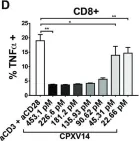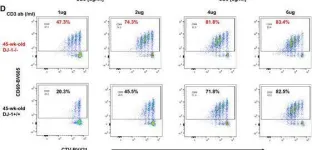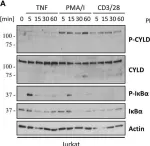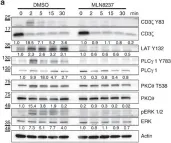Circulating Vitamin D (Vit-D) has emerged as a potent immune modulator in asthma, yet its direct impact on TH2 cell regulation, the central effectors of allergic inflammation, remains unclear. Preliminary transcriptomic analysis of neonatal cord blood revealed that gestational Vit-D deficiency corresponds to elevated adaptive and innate immune responses, driven by TH2 immunity and antimicrobial responses related to asthma inflammation. To elucidate cell-specific molecular mechanisms of Vit-D, we differentiated murine TH2 cells in vitro under conditions mimicking Vit-D sufficiency and deficiency. Our findings demonstrate that Vit-D exposure promotes intracellular calcium ion homeostasis while suppressing prominent inflammatory cytokines characteristic of asthma. Conversely, Vit-D deficiency reprograms TH2 cell lineage commitment, inducing overexpression of cytolytic molecules and major histocompatibility complex (MHC) class I molecules-traits typically associated with cytotoxicity rather than the canonical helper function. Our findings underscore Vit-D's role in stabilizing TH2 cell function and fate, offering insights into asthma and autoimmune disorders.
© 2025 The Authors.
Product Citations: 217
Vitamin D exerts endogenous control over TH2 cell fate and immune plasticity.
In IScience on 18 April 2025 by Fangal, V. D., Kilic, A., et al.
-
Immunology and Microbiology
-
Stem Cells and Developmental Biology
In Nature Communications on 16 April 2025 by Schmidt, A., Fuchs, J., et al.
Lung tissue-resident memory T cells (TRM) are critical for the local control of respiratory tract infections caused by influenza A viruses (IAV). Here we compare TRM populations induced by intranasal adenoviral vector vaccines encoding hemagglutinin and nucleoprotein (NP) with those induced by an H1N1 infection in BALB/c mice. While vaccine-induced TRM express high levels of CD103 and persist longer in the lung parenchyma, short-lived, H1N1-induced TRM have a transcriptome associated with higher cytotoxic potential and distinct transcriptional profile as shown by single-cell RNA sequencing. In both the vaccine and H1N1 groups, NP-specific CD8+ T cells expand during heterologous influenza virus infection and protect the mice from disease. Meanwhile, lung inflammation in response to an infection with unrelated respiratory syncytial virus do not influence the fate of pre-existing TRM. Our preclinical work thus confirms that inflammatory conditions in the tissue shape the phenotypic and functional characteristics of TRM to serve relevant informations for optimizing mucosal vaccines.
© 2025. The Author(s).
-
FC/FACS
-
Mus musculus (House mouse)
-
Immunology and Microbiology
Molecular basis for the calcium-dependent activation of the ribonuclease EndoU.
In Nature Communications on 1 April 2025 by Malard, F., Dias, K., et al.
Ribonucleases (RNases) are ubiquitous enzymes that process or degrade RNA, essential for cellular functions and immune responses. The EndoU-like superfamily includes endoribonucleases conserved across bacteria, eukaryotes, and certain viruses, with an ancient evolutionary link to the ribonuclease A-like superfamily. Both bacterial EndoU and animal RNase A share a similar fold and function independently of cofactors. In contrast, the eukaryotic EndoU catalytic domain requires divalent metal ions for catalysis, possibly due to an N-terminal extension near the catalytic core. In this study, we use biophysical and computational techniques along with in vitro assays to investigate the calcium-dependent activation of human EndoU. We determine the crystal structure of EndoU bound to calcium and find that calcium binding remote from the catalytic triad triggers water-mediated intramolecular signaling and structural changes, activating the enzyme through allostery. Calcium binding involves residues from both the catalytic core and the N-terminal extension, indicating that the N-terminal extension interacts with the catalytic core to modulate activity in response to calcium. Our findings suggest that similar mechanisms may be present across all eukaryotic EndoUs, highlighting a unique evolutionary adaptation that connects endoribonuclease activity to cellular signaling in eukaryotes.
© 2025. The Author(s).
-
RT-qPCR
-
Mus musculus (House mouse)
In Cell Death & Disease on 9 January 2025 by Chen, X., Zeng, Q., et al.
This research demonstrates that DCC-2036 (Rebastinib), a potent third-generation tyrosine kinase inhibitor (TKI), effectively suppresses tumor growth in colorectal cancer (CRC) models with functional immune systems. The findings underscore the capacity of DCC-2036 to enhance both the activation and cytotoxic functionality of CD8+ T cells, which are crucial for facilitating anti-tumor immune responses. Through comprehensive multi-omics investigations, significant shifts in both gene and protein expression profiles were detected, notably a marked decrease in DKK1 levels. This reduction in DKK1 was linked to diminished CD8+ T cell effectiveness, correlating with decreased FGR expression. Moreover, our findings identify FGR as a pivotal modulator that influences DKK1 expression via the PI3K-AKT-SP1 signaling cascade. Correlative analysis of clinical specimens supports the experimental data, showing that increased levels of FGR and DKK1 in CRC tissues are associated with inferior clinical outcomes and reduced efficacy of immunotherapeutic interventions. Consequently, targeting the FGR-AKT-SP1-DKK1 pathway with DCC-2036 could potentiate immunotherapy by enhancing CD8+ T cell functionality and their tumor infiltration. This strategy may contribute significantly to the refinement of therapeutic approaches for CRC, potentially improving patient prognoses.
© 2025. The Author(s).
-
Mus musculus (House mouse)
-
Cancer Research
-
Cell Biology
-
Immunology and Microbiology
In Cell Reports Medicine on 17 December 2024 by Zhou, S., Lin, W., et al.
Glioblastoma (GBM) stem cells (GSCs) contribute to poor prognosis in patients with GBM. Identifying molecular markers is crucial for developing targeted therapies. Here, we identify cluster of differentiation 97 (CD97) as an optimal GSC surface antigen for potential targeting by chimeric antigen receptor (CAR) T cell therapy through in vitro antibody screening. CD97 is consistently expressed in all validated patient-derived GSCs and positively correlated with known intracellular GSC markers. Silencing CD97 reduces GSC tumorigenicity-related activities, including self-renewal, proliferation, and tumor progression. Transcriptome analysis reveals that CD97 activates mTORC2, leading to AKT S473 phosphorylation and enhanced expression of the downstream genes ARHGAP1, BZW1, and BZW2. Inhibiting mTORC2 with JR-AB2-011 suppresses GSC tumorigenicity and downstream gene expression. We develop CD97-CAR T helper (Th) 9 cells, which exhibit potent cytotoxic effects in vitro and extend survival in mice. These findings suggest that CD97 is a promising GSC-enriched antigen and that targeting it with CAR Th9 cells offers a potential therapeutic strategy for GBM.
Copyright © 2024 The Author(s). Published by Elsevier Inc. All rights reserved.
-
Stem Cells and Developmental Biology
In PLoS Pathog on 1 September 2022 by Iyer, R. F., Edwards, D. M., et al.
Fig.3.D

-
FC/FACS
-
Mus musculus (House mouse)
Collected and cropped from PLoS Pathog by CiteAb, provided under a CC-BY license
Image 1 of 4
In EMBO Rep on 3 February 2022 by Zeng, N., Capelle, C. M., et al.
Fig.4.D

-
FC/FACS
-
Mus musculus (House mouse)
Collected and cropped from EMBO Rep by CiteAb, provided under a CC-BY license
Image 1 of 4
In Front Cell Dev Biol on 15 May 2018 by Lork, M., Kreike, M., et al.
Fig.2.A

-
WB
-
Mus musculus (House mouse)
Collected and cropped from Front Cell Dev Biol by CiteAb, provided under a CC-BY license
Image 1 of 4
In Nat Commun on 19 April 2016 by Blas-Rus, N., Bustos-Morán, E., et al.
Fig.8.A

-
WB
-
Mus musculus (House mouse)
Collected and cropped from Nat Commun by CiteAb, provided under a CC-BY license
Image 1 of 4



